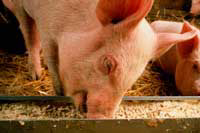Better gut health with more fibre in the diet

Feeding pigs more fibre may lead to less aggression and improve gut health while maintaining performance. However, type of fibre and feeding level are important factors influencing these effects.
According to Wageningen UR researcher Carol Souza da Silva “Fibre gives restricted-fed pigs more satiety, whereas ad libitum-fed growing pigs compensate the lower energy in fibrous diets by increasing intake.”
Souza da Silva tested different types of fibre in her research, but found that feeding fermentable fibres was best for pigs. “Such as cassava roots or raw potatoes.” The aim of her research was to determine how and which types of fibres influence satiety, to prevent pigs from becoming hungry between meals, thereby improving their welfare. In her research she noticed that pigs fed resistant starch maintained a ‘full’ feeling for up to more than seven hours after their meal. “The pigs were less hungry, which was also reflected in their behaviour. Moreover, resistant starch was found to change gene expression patterns and microbiotica composition in the hind gut, reflecting improved gut health and stabilized glucose levels.”
Feeding more fibre to sows prevents them feeling hungry, avoiding behavioural problems. More fibre in the ration is also good for fattening pigs, according to the researcher. “Their energy system can, to a large extent, adapt to this reduced energy ration. They compensate this by increasing their intake, consequently growth is then similar to fibre-free rations . In future our research will focus on the body composition after slaughter, which is influenced by fibrous diets.”
During her research Souza da Silva collaborated with human nutrition researchers. “They have similar questions about satiating effects of fibre and the role in prevention of overweight and obesity. The digestive physiology of pigs and humans is very similar”, she adds. “We supply each other with information and results.”
[Source: Wageningen UR Livestock Research]











